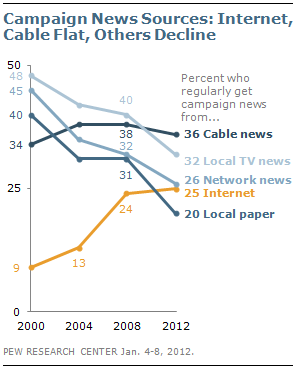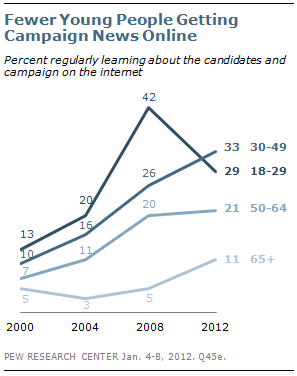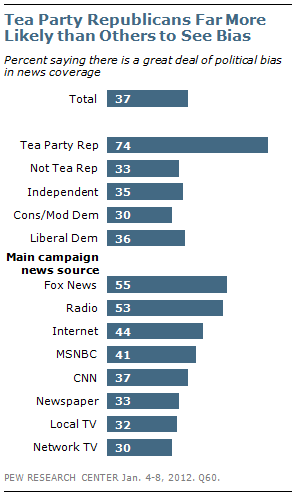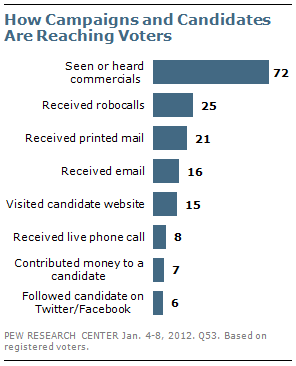Overview
With a contested primary in only one party this year, fewer Americans are closely following news about the presidential campaign than four years ago. As a consequence, long-term

declines in the number of people getting campaign news from such sources as local TV and network news have steepened, and even the number gathering campaign news online, which had nearly tripled between 2000 and 2008, has leveled off in 2012.
The one constant over the course of the past four elections is the reach of cable news. Currently, 36% of Americans say they are regularly learning about the candidates or campaign on cable news networks. That is virtually unchanged from previous campaigns, yet cable news is now the top regular source for campaign news.
The cable networks also hosted most of the candidate debates, which stand out as a particularly interesting aspect of the campaign. Nearly half of Republicans (47%) have watched a GOP debate during this campaign, up from 32% at a comparable point four years ago.
In contrast to cable, the Pew Research Center for the People & the Press’ 2012 campaign news survey, conducted Jan. 4-8 among 1,507 adults nationwide, finds broad declines in the numbers getting campaign news from newspapers, and local and network TV news. Just 20% say they regularly learn something about the presidential campaign or candidates from their local daily newspapers. In 2008, 31% said they got campaign news from their daily newspaper and 40% did so in the 2000 election cycle. There are comparable declines in the share regularly getting campaign information from network evening news programs and local TV news. For all three of these sources, the rate of decline slowed during the dramatic 2008 election cycle, but has again continued on a downward track.
In previous campaigns, declining figures for traditional sources were at least partly offset by increasing numbers turning to the internet. But that is not the case in 2012, as the number regularly getting campaign news online has leveled off. This is largely due to a lack of interest in the early 2012 campaign among younger Americans, who have traditionally been the broadest internet news consumers, and who also are less apt to be Republicans.

Over the month of January, only 20% of those younger than 30 said they were following news about the campaign very closely, down from 31% in January 2008. In fact, on the weekend Newt Gingrich won a dramatic victory in the South Carolina primary, young people expressed as much interest in a battle over online piracy legislation as they did in the campaign. (See “Cruise Ship Accident, Election Top Public’s Interests,” Jan. 24, 2012).
As campaign interest among young people has declined, fewer say they are going online for campaign news. Just 29% of those younger than 30 regularly learn something about the campaign online, down from 42% four years ago. Early in the 2008 campaign, people under age 30 were twice as likely as people 30 and older to get campaign information online. There is far less of an age gap today.
While other sources have advanced and receded, cable news networks have held their own over the past four election cycles. Moreover, cable news reaches a substantial number across age and partisan lines. To be sure, Republicans and Democrats are increasingly turning to different cable networks for their campaign news. When asked where they get most of their campaign news, far more Republicans than Democrats cite Fox News, while Democrats are much more likely than Republicans to cite CNN and MSNBC.
Few Learning from Social Networks

Many of the newest internet tools for getting campaign information, including social networking, are being used by a relatively limited audience. One-in-five Americans (20%) say they regularly or sometimes get campaign information from Facebook and just one-in-twenty (5%) say the same about Twitter. Even among Facebook and Twitter users, most say they hardly ever or never learn about the campaign or candidates through those sources.
About half (52%) of Americans say they at least sometimes learn about the campaign from websites or apps of TV, newspaper, magazine or radio news organizations. Slightly more than a third (36%) regularly or sometimes learn from websites or apps of news sources that are only available online.
When respondents are asked to name the specific internet sources they turn to for campaign news and information, the most frequently cited are CNN (by 24% of those who get campaign news online), Yahoo (22%), Google (13%), Fox News (10%), MSN (9%) and MSNBC (8%). Politically-oriented sites like Huffington Post and the Drudge Report are each mentioned by only 2% of those who get campaign news online.

More See Biased Coverage
The survey finds that the number saying there is a great deal of political bias in the news has risen to a new high, with the most intense criticism coming from Tea Party Republicans. Currently, 37% of Americans say there is a great deal of bias in news coverage and 30% say there is a fair amount of bias. Far fewer see not too much bias (21%) or none at all (10%). The percentage saying there is a great

deal of bias has increased six points, from 31% to 37%, since 2008.
About three-quarters (74%) of Republicans who agree with the Tea Party movement say there is a great deal of bias – at least twice the percentage as in any other political group, including non-Tea Party Republicans (33%) and liberal Democrats (36%). Among news audiences, those who cite the Fox News Channel or the radio as their main source of campaign news are the most likely to say there is a great deal of bias in news coverage.
Campaign Outreach
While new technology allows campaigns and groups multiple ways to reach out to voters, campaign commercials have by far the widest reach. Fully 72% of registered voters nationwide report having seen or heard campaign commercials related to the 2012 presidential campaign. That is far more than the percentages saying they have received email from a campaign or political group (16%), visited a candidate’s website (15%) or followed a candidate’s updates on Twitter or Facebook (6%).

While small, the number of people who track candidates on social networking has grown. At this point in the 2008 campaign, just 3% said they had signed up as a “friend” of a candidate on a social networking site.
One-in-four (25%) say they have already received pre-recorded telephone calls about the campaign, often referred to as “robocalls.” That is comparable to the level early in the 2008 presidential campaign. Only about a third as many (8%) have gotten phone calls from a live person. Telephone outreach has not been limited to Republicans. Democrats and Democratic-leaning voters are just as likely as Republicans and Republican leaners to have received live phone calls (8% each), and only slightly less likely to have received campaign robocalls (23% vs. 28% of Republicans).
Overall, 7% of registered voters say they have contributed money to a campaign, about the level measured early in the 2008 campaign (8% in Nov. 2007). But unlike four years ago, Democratic and Democratic-leaning voters are more likely than Republicans and Republican leaners to say they have contributed to a candidate – presumably Obama – in the 2012 campaign.




